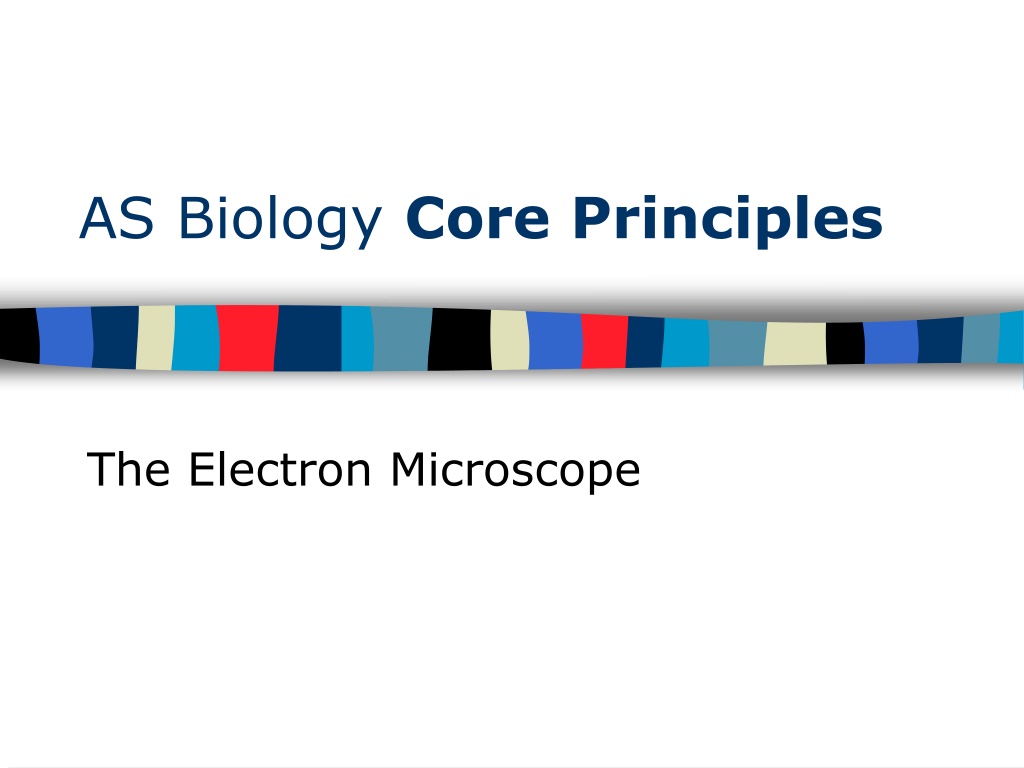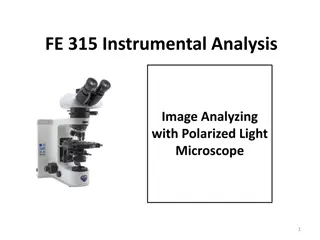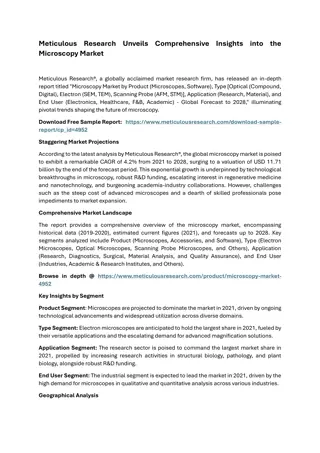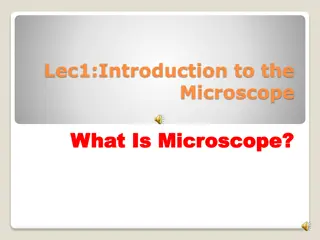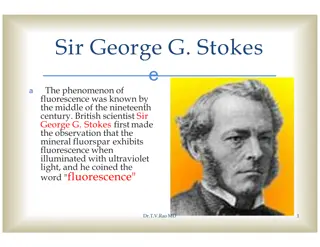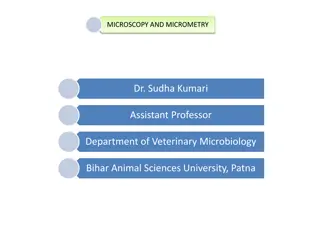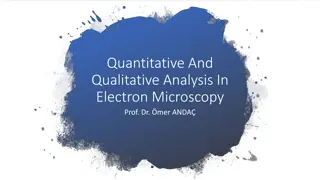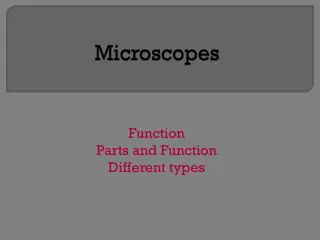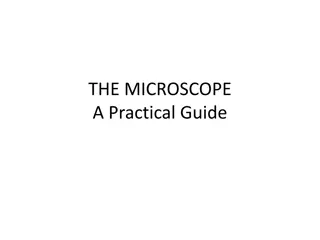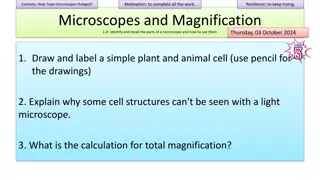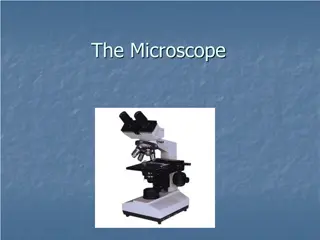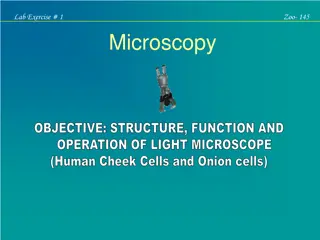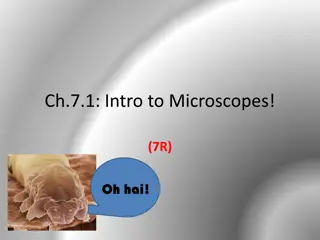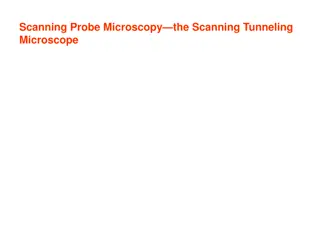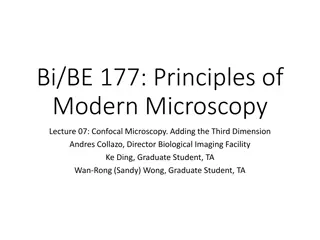Exploring Microscopy: Light vs Electron Microscopes
Microscopy has evolved significantly since Robert Hooke's discovery of cells in cork in 1665. This article delves into the fundamental principles of light and electron microscopes, discussing resolving power, magnification capabilities, and the differences between these two essential tools in biological research. Understanding how each microscope works and their unique features is crucial for scientists working at the microscopic level.
Download Presentation

Please find below an Image/Link to download the presentation.
The content on the website is provided AS IS for your information and personal use only. It may not be sold, licensed, or shared on other websites without obtaining consent from the author. Download presentation by click this link. If you encounter any issues during the download, it is possible that the publisher has removed the file from their server.
E N D
Presentation Transcript
AS Biology Core Principles The Electron Microscope
Aims Resolving power The resolving power of light & electron microscopes The difference between the light & electron microscope Transmission & scanning electron microscopy
Introduction Microscopes magnify & resolve images Microscopy began in 1665 when Robert Hooke coined the word cells to describe the structure of cork You need to know about 2 types of microscope - light & electron You need to know how they work and the differences between them Its not how much they magnify that is key - but how well they resolve
Resolving Power The limit of resolution of a microscope is the smallest distance between 2 points that can be seen using a microscope This is a measure of the clarity of the image A microscope with a high resolving power will allow 2 small objects which are close together to be seen as 2 distinct objects
Resolving Power Resolving power is inversely proportional to the wavelength of the radiation it uses
The Light Microscope Series of lenses through which ordinary white light can be focused Optical microscopes can not resolve 2 points closer together than about half (0.45) the wavelength of the light used (450- 600nm) How close is this?
The Light Microscope The total magnification is the eyepiece magnification multiplied by the objective magnification The maximum magnification of a light microscope is x1500 What can it be used for? What can it not be used for?
The Electron Microscope Electrons (negatively charged, very small particles) can behave as waves The wavelength of electrons is about 0.005nm What will this mean for the limit of resolution? Electrons are fired from an electron gun at the specimen and onto a fluorescent screen or photographic plate Where is this technique commonly used? There are 2 types of electron microscopy - transmission and scanning Both focus an electron beam onto the specimen using electromagnets
Transmission Electron Microscope (TEM) In transmission EM the electrons pass through the specimen Specimen needs to be extremely thin - 10nm to 100nm TEM can magnify objects up to 500 000 times TEM has made it possible to see the details of and discover new organelles - see page 9 in Collins
Transmission Electron Microscope (TEM) Cells or tissues are killed and chemically fixed in a complicated and harsh treatment (in full detail in table 3.1 pg 52 Rowland) How does this differ to light microscopy? This treatment can result in alterations to the cell - known as artefacts What will this mean for the images produced?
Transmission Electron Microscope (TEM) Transmission electron micrograph epithelial cells from a rat small intestine. Scale bar = 5 mm. of
Scanning Electron Microscope (SEM) In Scanning EM microscopes the electrons bounce off the surface of the specimen Produce images with a three-dimensional appearance Allow detailed study of surfaces
Scanning Electron Microscope (SEM) Now watch the following clip explaining SEM
Scanning Electron Microscope (SEM)
Links www.learn.co.uk/ www.microscopy-uk.org.uk/intro/index.html www.mwrn.com/feature/education.asp http://www.feic.com/support/tem/transmis.ht m http://anka.livstek.lth.se:2080/microscopy/fo odmicr.htm
Light & Electron Microscopes Copy & complete the following table Feature Light Microscope Electron Microscope Radiation used Radiation source Nature of lenses Lenses used Image seen Radiation medium Magnification Limit of resolution What it can show
This powerpoint was kindly donated to www.worldofteaching.com http://www.worldofteaching.com is home to over a thousand powerpoints submitted by teachers. This is a completely free site and requires no registration. Please visit and I hope it will help in your teaching.
